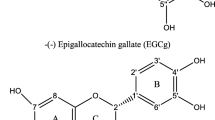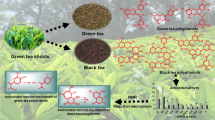Abstract
Researchers use several different analytical techniques, such as ORAC, ABTS·+, or FRAP, for measuring the antioxidant capacity of bioactive compounds. However, many authors do not take into account that these three techniques have different objectives. This contribution reports on the use of two types of tests to evaluate the antioxidant activity of four stilbene tests based first on the hydrogen atom transfer reaction (ORAC method) and the second on the single electron transfer reaction (ABTS·+ and FRAP assays). For the ORAC assay, the greatest antioxidant activity was shown by resveratrol, followed by oxyresveratrol, pterostilbene, and pinosylvin, while in the ABTS.+ assay, the highest antioxidant capacity was presented by oxyresveratrol, followed by resveratrol, pinosylvin, and finally pterostilbene. In the FRAP assay, the reducing activity shown by all the stilbenes was below that obtained for trolox. The role of phenolic hydroxyl groups was studied. The technique used should be selected taking into account the objectives and the conditions of the medium.

ᅟ





Similar content being viewed by others
References
Antikainen J, Hirvonen T, Kinnunen J, Hauta-Kasari M (2012) Heartwood detection for scotch pine by fluorescence image analysis. Holzforschung. doi:10.1515/hf-2011-0131
Aslam SN, Stevenson PC, Kokubun T, Hall DR (2009) Antibacterial and antifungal activity of cicerfuran and related 2-arylbenzofurans and stilbenes. Microbiol Res 164:191–195. doi:10.1016/j.micres.2006.11.012
Benzie IFF, Strain JJ (1996) The ferric reducing ability of plasma (FRAP) as a measure of “antioxidant power”: the FRAP assay. Anal Biochem 239:70–76. doi:10.1006/abio.1996.0292
Burns J, Yokota T, Ashihara H et al (2002) Plant foods and herbal sources of resveratrol. J Agric Food Chem 50:3337–3340. doi:10.1021/jf0112973
Cai Y-Z, Mei Sun N, Jie Xing N et al (2006) Structure-radical scavenging activity relationships of phenolic compounds from traditional Chinese medicinal plants. Life Sci 78:2872–2888. doi:10.1016/j.lfs.2005.11.004
Caruso F, Mendoza L, Castro P et al (2011) Antifungal activity of resveratrol against Botrytis cinerea is improved using 2-furyl derivatives. PLoS One 6:e25421. doi:10.1371/journal.pone.0025421
Çelik SE, Özyürek M, Güçlü K, Apak R (2010) Solvent effects on the antioxidant capacity of lipophilic and hydrophilic antioxidants measured by CUPRAC, ABTS/persulphate and FRAP methods. Talanta 81:1300–1309. doi:10.1016/j.talanta.2010.02.025
Choi HY, Lee J-H, Jegal KH et al (2016) Oxyresveratrol abrogates oxidative stress by activating ERK–Nrf2 pathway in the liver. Chem Biol Interact 245:110–121. doi:10.1016/j.cbi.2015.06.024
Chong J, Poutaraud A, Hugueney P (2009) Metabolism and roles of stilbenes in plants. Plant Sci 177:143–155. doi:10.1016/j.plantsci.2009.05.012
Dávalos A, Gómez-Cordovés C, Bartolomé B (2004) Extending applicability of the oxygen radical absorbance capacity (ORAC− fluorescein) assay. J Agric Food Chem 52:(1)48–54
de la Lastra CA, Villegas I (2007) Resveratrol as an antioxidant and pro-oxidant agent: mechanisms and clinical implications. Biochem Soc Trans 35:1156–1160. doi:10.1042/BST0351156
Escribano J, Pedreño MA, García-Carmona F, Muñoz R (1998) Characterization of the antiradical activity of betalains from Beta vulgaris L. roots. Phytochem Anal 9:124–127. doi:10.1002/(SICI)1099-1565(199805/06)9:3<124::AID-PCA401>3.0.CO;2-0
Frankel EN, Meyer AS (2000) The problems of using one-dimensional methods to evaluate multifunctional food and biological antioxidants. J Sci Food Agric 80:1925–1941. doi:10.1002/1097-0010(200010)80:13<1925::AID-JSFA714>3.0.CO;2-4
Gambini J, López-Grueso R, Olaso-González G et al (2013) Resveratrol: distribution, properties and perspectives. Rev Esp Geriatría Gerontol 48:79–88. doi:10.1016/j.regg.2012.04.007
Gandía-Herrero F, Cabanes J, Escribano J et al (2013) Encapsulation of the most potent antioxidant betalains in edible matrixes as powders of different colors. J Agric Food Chem 61:4294–4302. doi:10.1021/jf400337g
Gandía-Herrero F, Escribano J, García-Carmona F (2010) Structural implications on color, fluorescence, and antiradical activity in betalains. Planta 232:449–460. doi:10.1007/s00425-010-1191-0
Gandía-Herrero F, Escribano J, García-Carmona F (2009) The role of phenolic hydroxy groups in the free radical scavenging activity of betalains. J Nat Prod 72:1142–1146. doi:10.1021/np900131r
Huang D, Ou B, Prior RL (2005) The chemistry behind antioxidant capacity assays. J Agric Food Chem 53:1841–1856. doi:10.1021/jf030723c
Huang H-H, Li C-Q, Shao Z-H et al (2014) Abstract 335: resveratrol confers cardioprotection against ischemia/reperfusion injury by inhibition of JNK via AMPK. Circulation 130:A335–A335
Kasiotis KM, Pratsinis H, Kletsas D, Haroutounian SA (2013) Resveratrol and related stilbenes: their anti-aging and anti-angiogenic properties. Food Chem Toxicol Int J Publ Br Ind Biol Res Assoc 61:112–120. doi:10.1016/j.fct.2013.03.038
Katalinic V, Modun D, Music I, Boban M (2005) Gender differences in antioxidant capacity of rat tissues determined by 2,2′-azinobis (3-ethylbenzothiazoline 6-sulfonate; ABTS) and ferric reducing antioxidant power (FRAP) assays. Comp Biochem Physiol Toxicol Pharmacol CBP 140:47–52. doi:10.1016/j.cca.2005.01.005
Koskela A, Reinisalo M, Hyttinen JMT et al (2014) Pinosylvin-mediated protection against oxidative stress in human retinal pigment epithelial cells. Mol Vis 20:760–769
Laavola M, Nieminen R, Leppänen T et al (2015) Pinosylvin and monomethylpinosylvin, constituents of an extract from the knot of Pinus sylvestris, reduce inflammatory gene expression and inflammatory responses in vivo. J Agric Food Chem 63:3445–3453. doi:10.1021/jf504606m
López-Nicolás JM, Rodríguez-Bonilla P, Méndez-Cazorla L, García-Carmona F (2009) Physicochemical study of the complexation of pterostilbene by natural and modified cyclodextrins. J Agric Food Chem 57:5294–5300. doi:10.1021/jf900285e
Matsuoka A, Takeshita K, Furuta A et al (2002) The 4′-hydroxy group is responsible for the in vitro cytogenetic activity of resveratrol. Mutat Res Toxicol Environ Mutagen 521:29–35. doi:10.1016/S1383-5718(02)00211-5
Mikulski D, Molski M (2010) Quantitative structure–antioxidant activity relationship of trans-resveratrol oligomers, trans-4,4′-dihydroxystilbene dimer, trans-resveratrol-3-O-glucuronide, glucosides: trans-piceid, cis-piceid, trans-astringin and trans-resveratrol-4′-O-β-D-glucopyranoside. Eur J Med Chem 45:2366–2380. doi:10.1016/j.ejmech.2010.02.016
Nikhil K, Sharan S, Palla SR et al (2015) Understanding the mode of action of a pterostilbene derivative as anti-inflammatory agent. Int Immunopharmacol 28:10–21. doi:10.1016/j.intimp.2015.05.003
Pan Z, Agarwal AK, Xu T et al (2008) Identification of molecular pathways affected by pterostilbene, a natural dimethylether analog of resveratrol. BMC Med Genet 1:7. doi:10.1186/1755-8794-1-7
Paul B, Masih I, Deopujari J, Charpentier C (1999) Occurrence of resveratrol and pterostilbene in age-old darakchasava, an ayurvedic medicine from India. J Ethnopharmacol 68:71–76. doi:10.1016/S0378-8741(99)00044-6
Perečko T, Drábiková K, Ambrožová G et al (2015) Comparison of anti-inflammatory potential of pterostilbene and pinosylvin in vitro and in vivo. Eur J Clin Investig 45:60–61
Poulose SM, Thangthaeng N, Miller MG, Shukitt-Hale B (2015) Effects of pterostilbene and resveratrol on brain and behavior. Neurochem Int 89:227–233. doi:10.1016/j.neuint.2015.07.017
Re R, Pellegrini N, Proteggente A et al (1999) Antioxidant activity applying an improved ABTS radical cation decolorization assay. Free Radic Biol Med 26:1231–1237
Robb EL, Stuart JA (2014) The stilbenes resveratrol, pterostilbene and piceid affect growth and stress resistance in mammalian cells via a mechanism requiring estrogen receptor beta and the induction of Mn-superoxide dismutase. Phytochemistry 98:164–173. doi:10.1016/j.phytochem.2013.11.019
Rodríguez-Bonilla P, López-Nicolás JM, Méndez-Cazorla L, García-Carmona F (2011) Development of a reversed phase high performance liquid chromatography method based on the use of cyclodextrins as mobile phase additives to determine pterostilbene in blueberries. J Chromatogr B 879:1091–1097. doi:10.1016/j.jchromb.2011.03.025
Roupe KA, Remsberg CM, Yáñez JA, Davies NM (2006) Pharmacometrics of stilbenes: seguing towards the clinic. Curr Clin Pharmacol 1:81–101
Sasivimolphan P, Lipipun V, Likhitwitayawuid K et al (2009) Inhibitory activity of oxyresveratrol on wild-type and drug-resistant varicella-zoster virus replication in vitro. Antivir Res 84:95–97. doi:10.1016/j.antiviral.2009.07.010
Tian X, Schaich KM (2013) Effects of molecular structure on kinetics and dynamics of the trolox equivalent antioxidant capacity assay with ABTS+•. J Agric Food Chem 61:5511–5519. doi:10.1021/jf4010725
Wu JM, Wang ZR, Hsieh TC et al (2001) Mechanism of cardioprotection by resveratrol, a phenolic antioxidant present in red wine (review). Int J Mol Med 8:3–17
Xu S, Wang G, Liu H M, Wang LJ, Wang HF (2007) A DMol 3 study on the reaction between trans-resveratrol and hydroperoxyl radical: dissimilarity of antioxidant activity among O–H groups of transresveratrol. J Mol Struct THEOCHEM 809:(1)79–85
Yashiro T, Nanmoku M, Shimizu M et al (2012) Resveratrol increases the expression and activity of the low density lipoprotein receptor in hepatocytes by the proteolytic activation of the sterol regulatory element-binding proteins. Atherosclerosis 220:369–374. doi:10.1016/j.atherosclerosis.2011.11.006
Zhou J, Li S, Wang W et al (2013) Variations in the levels of Mulberroside A, oxyresveratrol, and resveratrol in mulberries in different seasons and during growth, variations in the levels of Mulberroside A, oxyresveratrol, and resveratrol in mulberries in different seasons and during growth. Sci World J Sci World J 2013:e380692. doi:10.1155/2013/380692
Author information
Authors and Affiliations
Corresponding author
Ethics declarations
Funding
This work was funded by the “Ministerio de Ciencia e Innovación” (MCINN, FEDER, Spain) (Project AGL2014–57431) and by “Programa de ayudas a Grupos de Excelencia de la Región de Murcia, de la Fundación Séneca, Agencia de Ciencia y Tecnología de la Región de Murcia” no. 19893/GERM/2015.
Ethical Approval
This article does not contain any studies with human participants or animals performed by any of the authors.
Informed Consent
Not applicable.
Conflict of Interest
A. Matencio has received a research grant (FPU UM) from the University of Murcia (R-1042/2015). P. Rodriguez-Bonilla declares that she has no conflict of interest. F. Gandía-Herrero declares that he has no conflict of interest. F. García Carmona declares that he has no conflict of interest and J.M. López-Nicolás declares that he has no conflict of interest.
Rights and permissions
About this article
Cite this article
Rodríguez-Bonilla, P., Gandía-Herrero, F., Matencio, A. et al. Comparative Study of the Antioxidant Capacity of Four Stilbenes Using ORAC, ABTS+, and FRAP Techniques. Food Anal. Methods 10, 2994–3000 (2017). https://doi.org/10.1007/s12161-017-0871-9
Received:
Accepted:
Published:
Issue Date:
DOI: https://doi.org/10.1007/s12161-017-0871-9




